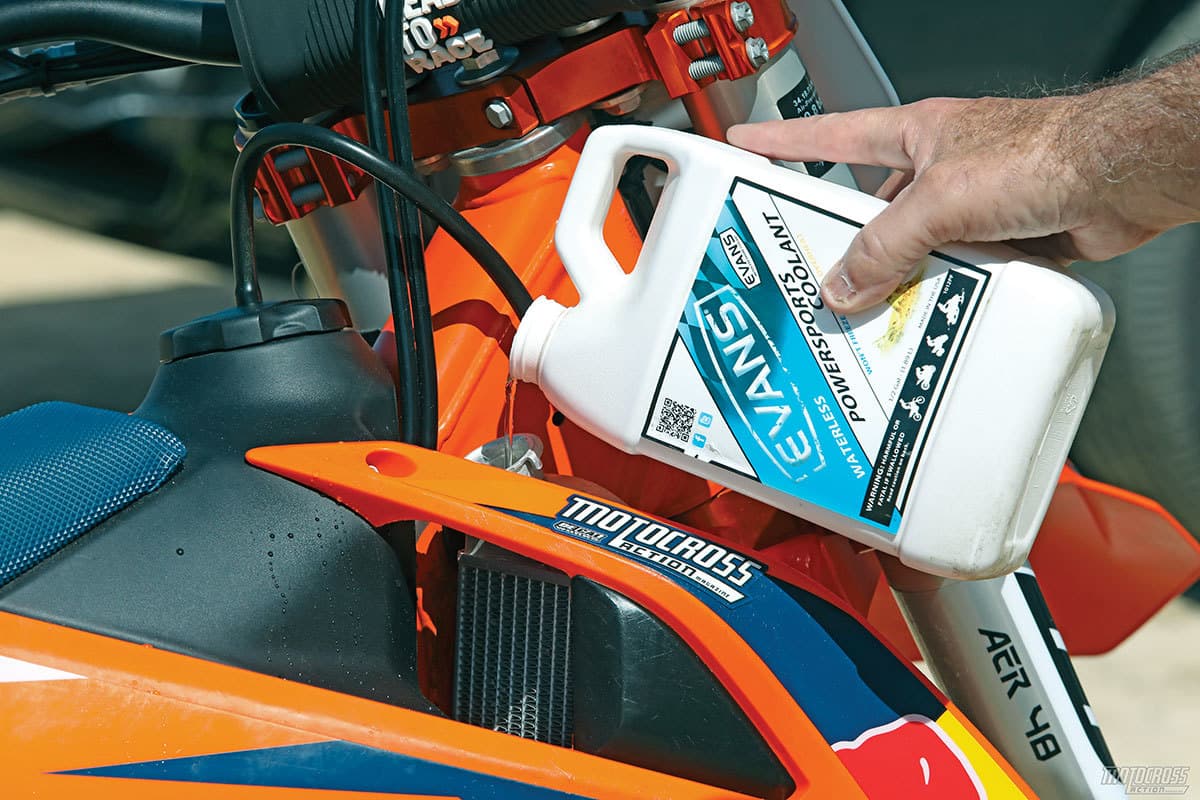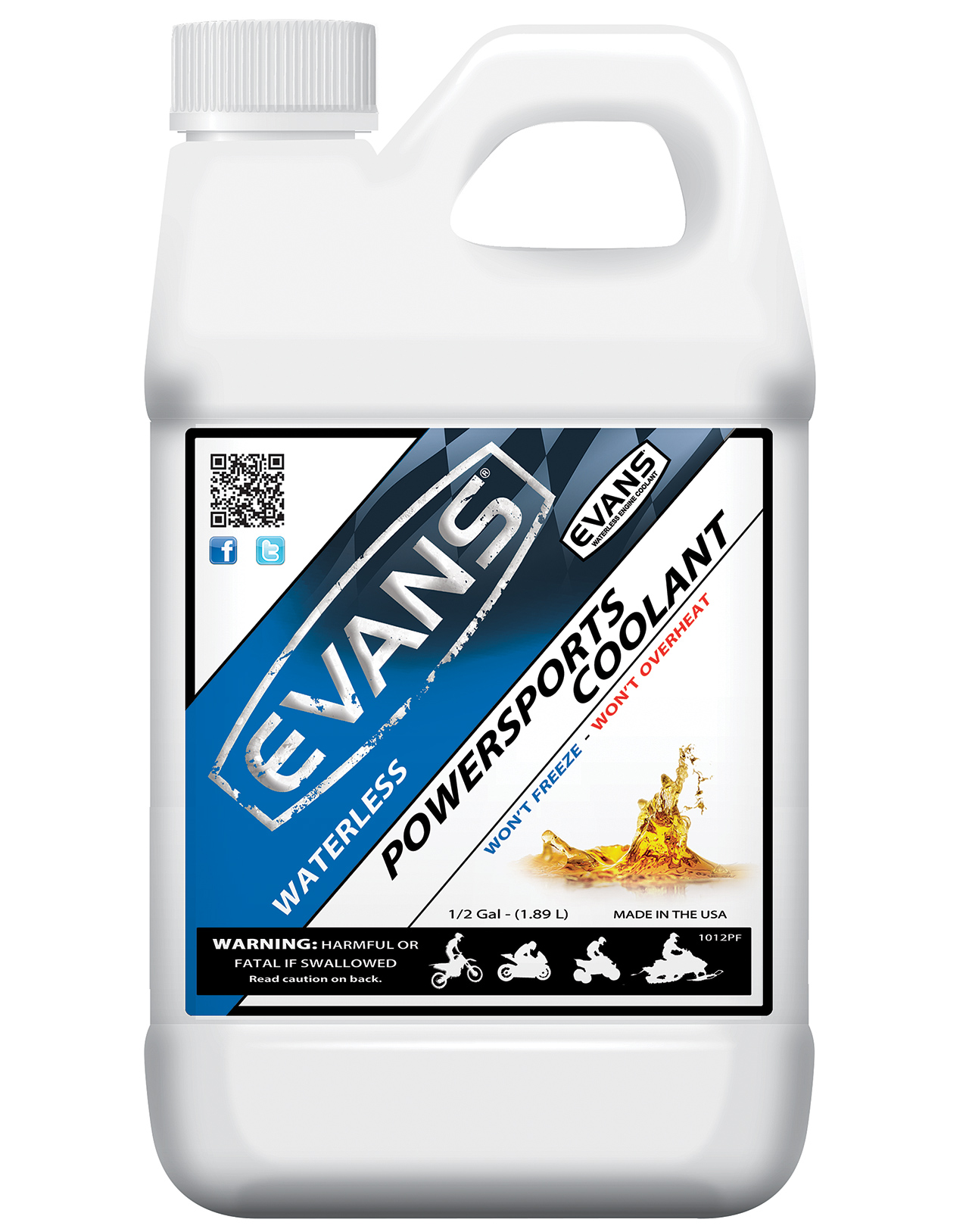TEN THINGS YOU NEED TO KNOW ABOUT WATERLESS COOLANT

(1) Waterless coolant. Let’s state the obvious: waterless coolant is different from regular coolant because there is no water in it. Waterless coolant is made up of the same basic glycols as regular coolant but operates much differently without the water. There are a few waterless coolant companies on the market, but only one markets worldwide and is highly involved in the motocross industry. That company is Evans waterless coolant. They let us in on some secrets, good and bad, on the effects of waterless coolant.
(2)Temperature. The boiling point of waterless coolant is 375 degrees Fahrenheit and it freezes at -40 degrees Fahrenheit. Instead of expanding when frozen, like water does, without the water, the coolant actually decreases in volume.
(3) Stability. Waterless coolant additives do not fall out of solution as with regular coolant. Stable additives are added to the waterless coolant so the coolant never goes bad, whether it is used or still sitting in the container, so it never has to be replaced.
(4) Vapor pressure. Waterless coolant doesn’t build vapor pressure in the system. There is moderate pressure build-up from a 7-percent fluid expansion, so if you open the radiator cap when the coolant is hot, it may spill out a few tablespoons, but it doesn’t have the vapor pressure that can blow up in your face like regular coolant. It must be said that if there is residual water still in the system (over 3 to 5 percent), vapor pressure will build.
(5) Mixing. If you have waterless coolant in your system and it is low and you didn’t bring extra waterless coolant to the track, don’t worry. You can add water or regular coolant to the system with no issues. With water added, it will behave just like regular coolant and lose the waterless-coolant benefits.
(6) ASTM. The ASTM, the organization that sets the bar in over 12,000 technical standards worldwide, has a waterless-coolant standard. So before making a purchase of waterless coolant, make sure it meets the ASTM standards to ensure you are investing in a high-performance product. (7) Corrosion. Many waterless coolants, including Evans’ old formula, would corrode with an addition of only 3-percent water. A waterless coolant that meets the ASTM standards can have up to 10-percent water and still retain its anti-corrosion properties. Evans Coolant will still protect with up to 60 percent water. It can’t, however, retain its lifetime use with water added and will go bad within a few years.
(7) Corrosion. Many waterless coolants, including Evans’ old formula, would corrode with an addition of only 3-percent water. A waterless coolant that meets the ASTM standards can have up to 10-percent water and still retain its anti-corrosion properties. Evans Coolant will still protect with up to 60 percent water. It can’t, however, retain its lifetime use with water added and will go bad within a few years.
(8) High temperatures. In long, hard races where the terrain is muddy, it is possible that mud can get packed into the radiators and restrict airflow and engine cooling. Regular coolant is going to boil out. If you don’t let the engine cool down or refill it, you will damage the engine. With waterless coolant, the engine will continue to run fine with restricted airflow, although it is possible that the plastic parts in the cooling system, such as the pump impeller or fittings holding the radiator hoses together, can melt. If these parts are plastic on your machine and you ride in extreme conditions for long periods of time, replace the plastic parts with metal ones.
(9) Hot spots. When you get vapor in the cylinder-head passages, the vapor pushes the liquid away from the metal in that spot, which raises the metal’s temperature by hundreds of degrees. This is what causes detonation, warped heads and blown head gaskets. These hot spots don’t develop with waterless coolant, because the waterless liquid will always be in contact with the metal to cool it down.
(10) Conversion. To ensure you get the full benefits of waterless coolant, the cooling system must be completely drained or have a maximum of only 3-percent water. The best way to ensure this is to remove the drain bolt, then pull the hose off at the pump. Now, blow compressed air in at the top of the radiator. Put the hose and drain bolt back in (finger-tight) and pour one or two cups of either the waterless coolant or prep fluid (the prep fluid is the cheaper route) in the radiator. Then, drain and blow it out again before the final assembly and coolant fill.





Comments are closed.